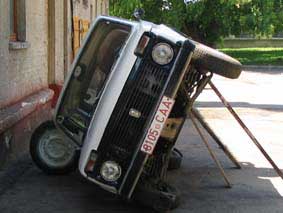
| Home
| Newbies Guide | Technical Resources
| Lada Niva Clubs | Niva
Lift Kits | Gallery | Links
|




As someone whose daily driver, and frequently only car, is a Niva, I'd have some reservations about an older carburettor based Niva as a daily driver for some people.
But then it might be the ideal car for others...
You need to carefully determine your priorities in a daily car - a Niva may well be the perfect daily for you. But it also may not.
Please note: this advice mostly does not really apply to the newer and fuel-injected Nivas - I know very little about these, and I expect they are perfectly reliable and generally need not too much more than simple regular DIY servicing, making them a good daily.
Actually quite reliable, but...
Yes, Niva's are vastly more reliable than Lada's reputation is generally believed to be. Indeed, my 25 year-old Niva has (touch wood!) never failed to get me home - even with a serious gearbox failure, or a broken distributor.
But some older Nivas can be a bit of a headache, especially if you don't have the time or ability for Do-It-Yourself. The best quote I've seen to sum up an older Niva is "Nivas are always half broken, but never broken down". This sums my own Niva up very well.
Do-it-yourself Ethic
Older Nivas are not an ideal car for someone with little or no mechanical knowledge, or at least without the inclination to learn. But they are excellent for someone with a bit of knowledge or ability, or someone who wants to learn more about cars. Nivas are the ultimate Punk car - born in '77, huge do-it-yourself ethic, and turns heads on the streets amongst the look-alike cars and SUVs of today.
Respect your Elders
While Nivas are vastly more reliable than their reputation, they are an older design. While this makes them reasonably easy to maintain yourself, it also means they will never be as reliable as a modern Japanese etc car. This no reflection on Lada - no carburettor and points ignition car ever will be reliable as a good modern electronic-ignition and fuel-injected car for turn-the-key-and-forget-the-rest daily driving.
A Lada "cool". Are you mental?
Yes, Nivas are even becoming "cool" - the last time myself and another Niva owning buddy were ferrying students about at the polytechnic where I work, our young passengers remarked what “cool retro cars” the Nivas were - none had heard of Lada of course. But more amazingly virtually none knew of the Soviet Union - and I'm not sure whether that, or a Niva being called "cool" by young folk, stunned me the most. :lol:
The Niva has a personality most interesting people can't help but like. Even Top Gear's renowned Lada hater, Jeremy Clarkson, concedes the Niva is “...is quite a rugged personable little thing … the sort of car, you could give it a name”. And James May, hater of all things proletarian, admits in a 2011 review that the Niva “...is actually quite good”.
Get a good one - and Maintain it
Getting a good Niva in the first place, and doing preventative maintenance is essential to running a Niva. If you don't have the time or inclination to do the maintenance, you're probably best to forget a older Niva as a daily car.
But if you want a 'real' car where you can learn to tune and maintain it - a Niva is probably ideal. And you'll get a capable and cheap 4x4 to as a bonus.
Ideally, choose a Niva that is in good condition and has been maintained properly with servicing as per the manual and with genuine parts. Sadly due to the Niva's ability to chug away seemingly forever and the thrifty nature of some owners, many have had low or zero maintenance or have been serviced with non-genuine parts, giving Nivas an undeserved poor name.
Parts?
Replacement parts can also be a bit of a hassle if you don't live somewhere with a Lada dealer (see the Newbies Guide for a list of parts dealers). Most common replacement parts are still carried by retailers (eg, brakes, clutches, points, etc), but genuine Lada/VAZ parts are generally best to use - and as a bonus, generally very reasonably priced compared to rival 4x4s.
Where I live genuine parts are available, but they must be ordered from out of town. Nice dealer, generally good prices and sends stuff out quickly.
But still it's at least day or two delay compared to being able to get parts off-the-shelf locally; eg if you only have weekends for maintenance this can mean a week's delay in repairs if a faulty part is diagnosed on a Saturday afternoon compared to buying of the shelf and doing the job on Sunday. No good it it's a daily. Secondhand bits are also a bit scarce, and accessories very rare where I live.
Of course if you live somewhere where Nivas are common, or that has a nearby parts dealer, you'll have no such supply worries.
Tyres can be problem as affordable 16" tyres to fit the Niva are difficult to find where I live. Though if you live somewhere Nivas are common you can easily find a set of dealer fitted Niva 15" rims (generally 15" Niva sized tyres are much easier to find), or indeed Niva sizes tyres many even be more commonly available.
The WOF/MOT test can be a hassle as well if they have overly strict standards where you live. My 25 year old Niva almost always needs some work to pass (usually minor but time-consuming), but we have stupidly strict roadworthiness tests in New Zealand.
Power-assisted What's-it?
Some people find the lack of power steering a problem for daily driving in a Niva (especially with wider tyres fitted). Other than parking and on a 4x4 trial, I personally do not find this an issue (but I have plenty of upper body strength), though I don't like having to do a lot of parking maneuvers that involve lots of low speed lock-to-lock steering and I generally avoid such.
Power windows, locks, etc are available for Nivas - but really, why? If you what power assisted this-and-that you're possibly missing the point of a Niva. Of course if necessary to the daily grind more bearable, there are indeed many such upgrades and modifications you can do to a Niva to make it more handy and comfortable.
The heater is the best Niva accessory. When all is working well it can heat the interior to something like 20C in -20C outside.
Fuel economy
The main reason I avoid a carburetor Niva for a daily driver is - economy. Unless you have an injected one (or are lucky), some Nivas seem to be on the thirsty side. Mine's often well on the thirsty side and typically get less 300Km from its 40 litre tank.
Many Niva owners happily report 10litres / 100km, but like many other carburettor Niva owners mine has never really achieved that. Of course, you could do a decent tune up and aim for that 10l / 100.
Note that no 4x4 will be an economy car. While great fun, at the end of the day the permanent 4WD ability - and associated running costs - of all SUVs are simply not really necessary for most people's daily driving, but you're still paying for it. Of course on the one or two snow days we do have per year, everyone in the office who lives on a hill is certainly my friend :lol:
Weekend Warrior
Don't get me wrong, I love driving my Niva - and I love tinkering with cars. But for convenience and economy I generally use a Japper as my main daily - and save mileage on the Niva for fun in the weekends.
Well in theory.
I often actually still use the Niva as a daily as the mood suits.
Want to buy a Niva?
Check out 4x4Mart's Buyers Guide and/or Australian 4x4 Monthly's Buyers Guide
Just bought Niva?
Check out my Niva Newbies Guide
This page lives at the www.ladaniva.co.uk/baxter domain, if you’re reading it from anywhere else you may not be reading the most up-to-date copy.
| Home | Newbies Guide | Cloggy's DOHC | Lada Niva Clubs | Niva Lift Kits | Gallery | Links |
Please read the General Disclaimer near the bottom of this page